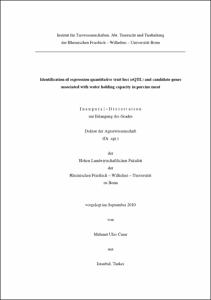Cinar, Mehmet Ulas: Identification of expression quantitative trait loci (eQTL) and candidate genes associated with water holding capacity in porcine meat. - Bonn, 2011. - Dissertation, Rheinische Friedrich-Wilhelms-Universität Bonn.
Online-Ausgabe in bonndoc: https://nbn-resolving.org/urn:nbn:de:hbz:5N-24084
Online-Ausgabe in bonndoc: https://nbn-resolving.org/urn:nbn:de:hbz:5N-24084
@phdthesis{handle:20.500.11811/4710,
urn: https://nbn-resolving.org/urn:nbn:de:hbz:5N-24084,
author = {{Mehmet Ulas Cinar}},
title = {Identification of expression quantitative trait loci (eQTL) and candidate genes associated with water holding capacity in porcine meat},
school = {Rheinische Friedrich-Wilhelms-Universität Bonn},
year = 2011,
month = jan,
note = {Consumer assessment of meat quality is defined by the characteristics of sensory experience such as juiciness, muscle pH, water-holding capacity and colour. Water-holding capacity in terms of drip loss has a genetic as well as environmental component with low to medium heritability. The number of genes involved in the development of drip loss is unknown. The aim of this study was to identify the candidate genes and their transcriptional regulation responsible for the drip loss in pig meat.
Twenty genes were selected for the candidate gene analysis and for their eQTL study. For the expression of genes quantitative real-time PCR and GenomeLab GeXP multi-plex were used in 300 DUPI animals. Multiple housekeeping genes were used for the accurate gene expression normalization. Analysis revealed expression of peroxisome proliferator activated receptor gamma, coactivator 1 alpha (PPARGC1) and alpha 1 microglobulin/bikunin (AMBP) genes were differentially regulated in animals with higher drip loss compared to lower drip loss. Moreover, expression of other genes showed significant association with different meat quality parameters. eQTL analysis showed that these genes are trans-regulated in DUPI population. By using different QTL models, on SSC2 vicinity of marker S0141 was detected as the most promising chromosomal region for drip loss supported by the literature as well. Ovelapping of detected eQTL with QTL in DUPI population and other pig populations showed promising chromosomal regions for further fine mapping and association studies.},
url = {https://hdl.handle.net/20.500.11811/4710}
}
urn: https://nbn-resolving.org/urn:nbn:de:hbz:5N-24084,
author = {{Mehmet Ulas Cinar}},
title = {Identification of expression quantitative trait loci (eQTL) and candidate genes associated with water holding capacity in porcine meat},
school = {Rheinische Friedrich-Wilhelms-Universität Bonn},
year = 2011,
month = jan,
note = {Consumer assessment of meat quality is defined by the characteristics of sensory experience such as juiciness, muscle pH, water-holding capacity and colour. Water-holding capacity in terms of drip loss has a genetic as well as environmental component with low to medium heritability. The number of genes involved in the development of drip loss is unknown. The aim of this study was to identify the candidate genes and their transcriptional regulation responsible for the drip loss in pig meat.
Twenty genes were selected for the candidate gene analysis and for their eQTL study. For the expression of genes quantitative real-time PCR and GenomeLab GeXP multi-plex were used in 300 DUPI animals. Multiple housekeeping genes were used for the accurate gene expression normalization. Analysis revealed expression of peroxisome proliferator activated receptor gamma, coactivator 1 alpha (PPARGC1) and alpha 1 microglobulin/bikunin (AMBP) genes were differentially regulated in animals with higher drip loss compared to lower drip loss. Moreover, expression of other genes showed significant association with different meat quality parameters. eQTL analysis showed that these genes are trans-regulated in DUPI population. By using different QTL models, on SSC2 vicinity of marker S0141 was detected as the most promising chromosomal region for drip loss supported by the literature as well. Ovelapping of detected eQTL with QTL in DUPI population and other pig populations showed promising chromosomal regions for further fine mapping and association studies.},
url = {https://hdl.handle.net/20.500.11811/4710}
}






